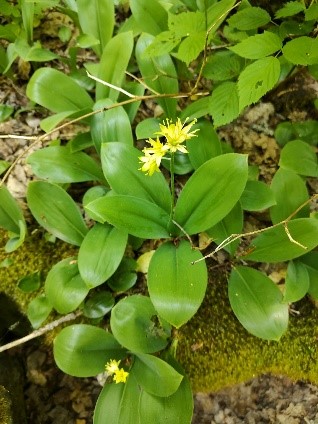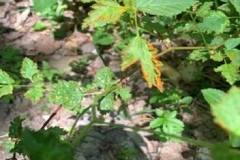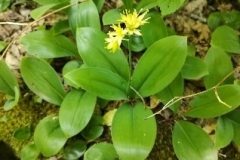By Lindsay Piotrowski and Jason Kappan, Invasive Species Survey and Monitoring Technicians
At the beginning of the 2023 field season, WNY PRISM Survey and Monitoring Technicians focused on geographic data gap surveys. Geographic data gaps are areas in the WNY PRISM region where few invasive species observations have been uploaded to iMapInvasives. Geographic data gap surveys provide information on the presence and distribution of invasive species in these under-surveyed areas. Survey Techs completed surveys at Rock City and McCarty Hill State Forests, Boyce Hill State Forest, East Otto State Forest and Holcomb Pond in Zoar Valley MUA, all sites in Cattaraugus County.
In May, we surveyed Boyce Hill State Forest, a 971-acre forest located in Franklinville that allows hunting, horseback riding, camping, hiking and fishing. The Finger Lakes Trail Conference and Foothills Trail Club maintain the trail so people can enjoy the forest. But recreational activities can provide pathways for invasive species to spread into the area as well. This area had a lot of space free of invasive species which is great to see, and six different invasive species were found scattered along the trail. These included: beech leaf disease (Litylenchus crenatae mccannii), bush honeysuckle (Lonicera spp.), garlic mustard (Alliaria petiolata), glossy buckthorn (Frangula alnus), multi-flora rose (Rosa multiflora) and reed canarygrass (Phalaris arundinacea). Location data for each species along with information on distribution, percent cover and phenology were collected and will all get uploaded into iMapInvasives so land managers in the area can use the data as needed.
At Boyce Hill, we noticed some noteworthy things other than the invasive species we were mapping. One interesting find was the maple velvet erineum gall mite (Aceria aceris). The mites are related to arachnids but only have two pairs of legs and are microscopic. But we were able to see the galls they produce which are bright red, crimson, or green and look like paint splotches on leaves. We also saw a fungus pathogen called blackberry orange rust (Gymnoconia nitens). As the name suggests the fungus affects the genus Rubus and creates an orange rust look on leaves and causes them to crinkle up. These species provided an opportunity expand our identification skills outside of invasive plants.
We were also able to survey Rock City and McCarthy Hill State Forests, near Ellicottville, which are connected and comprise approximately 6,229 acres. Similar to Boyce Hill, these forests provide many recreational opportunities. Some additional invasive species were found during this data gap survey including autumn olive (Elaeagnus umbellata), mugwort (Artemisia vulgaris) and periwinkle (Vinca minor) and they were present in low densities. Again, data was collected and will be uploaded so it can be used to inform future management work.Due to the low invasive species cover, we got to see many nice native species as well. Bluebead lily (Clintonia borealis) has flowers that are yellow, and the plant gets its name from the striking deep blue berries it produces in mid to late summer. They certainly stand out in comparison to the brown and green colors of the forest floor. Another native species we came across was painted trillium (Trillium undulatum). It is easily identifiable because of its three dark green leaves and single terminal flower. The white flower has a reddish-purple splotch at the base. The flowers bloom from early to late spring so it was perfect timing to catch this perennial flower at Rock City State Forest.
Looking back on these surveys it was a great beginning to the 2023 season. We got a lot of in the field practice identifying common terrestrial invasive plants in addition to forest pests and some native species. From watching hawks and vultures fly above to toads hop and centipedes crawl below us, this was a fun way to kick off the field season!





